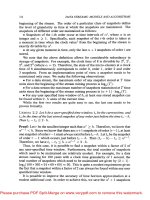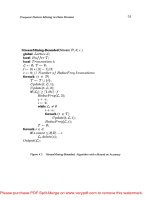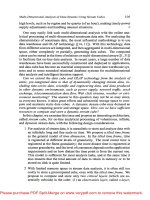Software Processes
Bạn đang xem bản rút gọn của tài liệu. Xem và tải ngay bản đầy đủ của tài liệu tại đây (126.06 KB, 17 trang )
©Ian Sommerville 2004 Software Engineering, 7th edition. Chapter 4 Slide 1
Software Processes
©Ian Sommerville 2004 Software Engineering, 7th edition. Chapter 4 Slide 2
Objectives
To introduce software process models
To describe three generic process models and
when they may be used
To describe outline process models for
requirements engineering, software
development, testing and evolution
To explain the Rational Unified Process model
To introduce CASE technology to support
software process activities
©Ian Sommerville 2004 Software Engineering, 7th edition. Chapter 4 Slide 3
Topics covered
Software process models
Process iteration
Process activities
The Rational Unified Process
Computer-aided software engineering
©Ian Sommerville 2004 Software Engineering, 7th edition. Chapter 4 Slide 4
The software process
A structured set of activities required to develop a
software system
• Specification;
• Design;
• Validation;
• Evolution.
A software process model is an abstract representation
of a process. It presents a description of a process
from some particular perspective.
©Ian Sommerville 2004 Software Engineering, 7th edition. Chapter 4 Slide 5
Generic software process models
The waterfall model
• Separate and distinct phases of specification and
development.
Evolutionary development
• Specification, development and validation are
interleaved.
Component-based software engineering
• The system is assembled from existing components.
There are many variants of these models e.g. formal
development where a waterfall-like process is used but
the specification is a formal specification that is refined
through several stages to an implementable design.
©Ian Sommerville 2004 Software Engineering, 7th edition. Chapter 4 Slide 6
Waterfall model
Requir ements
definition
System and
software design
Implementa tion
and unit testing
Integ ration and
system testing
Oper ationand
maintenance
©Ian Sommerville 2004 Software Engineering, 7th edition. Chapter 4 Slide 7
Waterfall model phases
Requirements analysis and definition
System and software design
Implementation and unit testing
Integration and system testing
Operation and maintenance
The main drawback of the waterfall model is
the difficulty of accommodating change after
the process is underway. One phase has to be
complete before moving onto the next phase.
©Ian Sommerville 2004 Software Engineering, 7th edition. Chapter 4 Slide 8
Waterfall model problems
Inflexible partitioning of the project into distinct stages
makes it difficult to respond to changing customer
requirements.
Therefore, this model is only appropriate when the
requirements are well-understood and changes will be
fairly limited during the design process.
Few business systems have stable requirements.
The waterfall model is mostly used for large systems
engineering projects where a system is developed at
several sites.
©Ian Sommerville 2004 Software Engineering, 7th edition. Chapter 4 Slide 9
Evolutionary development
Exploratory development
• Objective is to work with customers and to evolve
a final system from an initial outline specification.
Should start with well-understood requirements
and add new features as proposed by the
customer.
Throw-away prototyping
• Objective is to understand the system
requirements. Should start with poorly understood
requirements to clarify what is really needed.
©Ian Sommerville 2004 Software Engineering, 7th edition. Chapter 4 Slide 10
Evolutionary development
Concurr ent
acti vities
Valida tion
Final
version
Development
Intermedia te
versions
Specifica tion
Initial
version
Outline
description
©Ian Sommerville 2004 Software Engineering, 7th edition. Chapter 4 Slide 11
Evolutionary development
Problems
• Lack of process visibility;
• Systems are often poorly structured;
• Special skills (e.g. in languages for rapid
prototyping) may be required.
Applicability
• For small or medium-size interactive systems;
• For parts of large systems (e.g. the user interface);
• For short-lifetime systems.
©Ian Sommerville 2004 Software Engineering, 7th edition. Chapter 4 Slide 12
Component-based software engineering
Based on systematic reuse where systems are
integrated from existing components or COTS
(Commercial-off-the-shelf) systems.
Process stages
• Component analysis;
• Requirements modification;
• System design with reuse;
• Development and integration.
This approach is becoming increasingly used
as component standards have emerged.
©Ian Sommerville 2004 Software Engineering, 7th edition. Chapter 4 Slide 13
Reuse-oriented development
Requirements
specification
Component
analysis
Development
and integ ration
System design
with reuse
Requirements
modification
System
validation
©Ian Sommerville 2004 Software Engineering, 7th edition. Chapter 4 Slide 14
Process iteration
System requirements ALWAYS evolve in the
course of a project so process iteration where
earlier stages are reworked is always part of
the process for large systems.
Iteration can be applied to any of the generic
process models.
Two (related) approaches
• Incremental delivery;
• Spiral development.
©Ian Sommerville 2004 Software Engineering, 7th edition. Chapter 4 Slide 15
Incremental delivery
Rather than deliver the system as a single delivery, the
development and delivery is broken down into
increments with each increment delivering part of the
required functionality.
User requirements are prioritised and the highest
priority requirements are included in early increments.
Once the development of an increment is started, the
requirements are frozen though requirements for later
increments can continue to evolve.
©Ian Sommerville 2004 Software Engineering, 7th edition. Chapter 4 Slide 16
Incremental development
Valida te
increment
Develop system
increment
Design system
architectur e
Integ rate
increment
Validate
system
Define outline
requirements
Assign requirements
to increments
System incomplete
Final
system
©Ian Sommerville 2004 Software Engineering, 7th edition. Chapter 4 Slide 17
Incremental development advantages
Customer value can be delivered with each
increment so system functionality is available
earlier.
Early increments act as a prototype to help
elicit requirements for later increments.
Lower risk of overall project failure.
The highest priority system services tend to
receive the most testing.
©Ian Sommerville 2004 Software Engineering, 7th edition. Chapter 4 Slide 18
Extreme programming
An approach to development based on the
development and delivery of very small
increments of functionality.
Relies on constant code improvement, user
involvement in the development team and
pairwise programming.
Covered in Chapter 17









